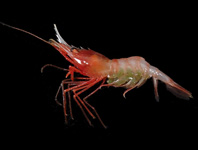Abstract
Cambarellus (Pandicambarus) rotatus, new species, is a dwarf crayfish from floodplain swamps in the Tombigbee and Black Warrior river drainages of Greene, Hale, and Marengo counties, Alabama. The new species is morphologically most similar to Cambarellus (Pandicambarus) lesliei. They differ in a several morphological characters. Cambarellus rotatus, new species, has gonopods that are rotated mesially so that the terminal elements oppose each other, and they have a short C-shaped sperm groove. These are unique features among known species of Cambarellus.
References
Black, J.B. (1966) Cyclic male reproductive activities in the dwarf crawfishes Cambarellus shufeldtii (Faxon) and Cambarellus puer Hobbs. Transactions of the American Microscopical Society, 85, 214–232.
https://doi.org/10.2307/3224632Faxon, W. (1884) Descriptions of new species of Cambarus: to which is added a synonical list of the known species of Cambarus and Astacus. Proceedings of the American Academy of Arts and Sciences, 20, 107–158.
https://doi.org/10.2307/25138768Fitzpatrick, J.F. (1983) A revision of the dwarf crawfishes (Cambaridae, Cambarellinae). Journal of Crustacean Biology, 3, 266–277.
https://doi.org/10.2307/1548262Fitzpatrick Jr., J.F. & Laning, B.A. (1976) A new dwarf crawfish (Decapoda: Cambaridae: Cambarellinae) from Southwest Alabama and adjacent Mississippi. Proceedings of the Biological Society of Washington, 89, 137–146.
Hobbs Jr., H.H. (1942) A generic revision of the crayfishes of the subfamily Cambarinae (Decapoda, Astacidae) with the description of a new genus and species. The American Midland Naturalist, 28, 334–357.
https://doi.org/10.2307/2420820Hobbs Jr., H.H. (1945) Two new species of crayfishes of the genus Cambarellus from the Gulf Coastal states, with a key to the species of the genus (Decapoda, Astacidae). The American Midland Naturalist, 34, 466–474.
https://doi.org/10.2307/2421134Hobbs Jr., H.H. (1989) An illustrated checklist of the American crayfishes (Decapoda: Astacidae, Cambaridae, and Parastacidae). Smithsonian Institution Press. Washington, D.C.
Master, L. (1990) Assessing threats and setting priorities for conservation. Conservation Biology 5, 559–563.
https://doi.org/10.1111/j.1523-1739.1991.tb00370.xOrtmann, A.E. (1905) The mutual affinities of the species of the genus Cambarus, and their dispersal over the United States. Proceedings of the American Philosophical Society, 64, 91–137.
https://doi.org/10.5962/bhl.title.16019Penn, G.H. (1942) Observations on the biology of the dwarf crawfish, Cambarellus shufeldtii (Faxon). The American Midland Naturalist, 28, 644–647.
https://doi.org/10.2307/2420896Penn, G.H. (1950) The genus Cambarellus in Louisiana (Decapoda, Astacidae). The American Midland Naturalist, 44, 42–426.
Schuster, G.A., Taylor, C.A. & Johansen, J. (2008) An annotated checklist and preliminary designation of drainage distributions of the crayfishes of Alabama. Southeastern Naturalist, 7, 493–504.
https://doi.org/10.1656/1528-7092-7.3.493Smith, J.B., Schuster, G.A., Taylor, C.A., Wynn, E.A. & McGregor, S.W. (2011) A preliminary report on the distribution and conservation status of the Alabama crayfish fauna In Ecosystems Investigation Program. Geologic Survey of Alabama, Tuscaloosa, AL, 189 pp.
Soil Survey Staff, Natural Resources Conservation Service, United States Department of Agriculture (2016) Web Soil Survey. Available from: http://websoilsurvey.nrcs.usda.gov/ (accessed 10 February 2016)
Stites, A.J., Taylor, C.A. & Schuster, G.A. (2014) Final Report: Status survey for three rare Alabama crayfishes: Cambarellus diminutus, Fallicambarus burrisi, and Procambarus lagniappe. In: Illinois Natural History Survey Technical Report, 40, 1–23.
Taylor, C.A., Schuster, G.A., Cooper, J.E., DiStefano, R.J., Eversole, A.G., Hamr, P., Hobbs, H.H., III, Robison, H.W., Skelton, C.E. & Thoma, R.F. (2007) A reassessment of the conservation status of crayfishes of the United States and Canada after 10+ years of increased awareness. Fisheries, 32, 372–389.
https://doi.org/10.1577/1548-8446(2007)32[372:AROTCS]2.0.CO;2

